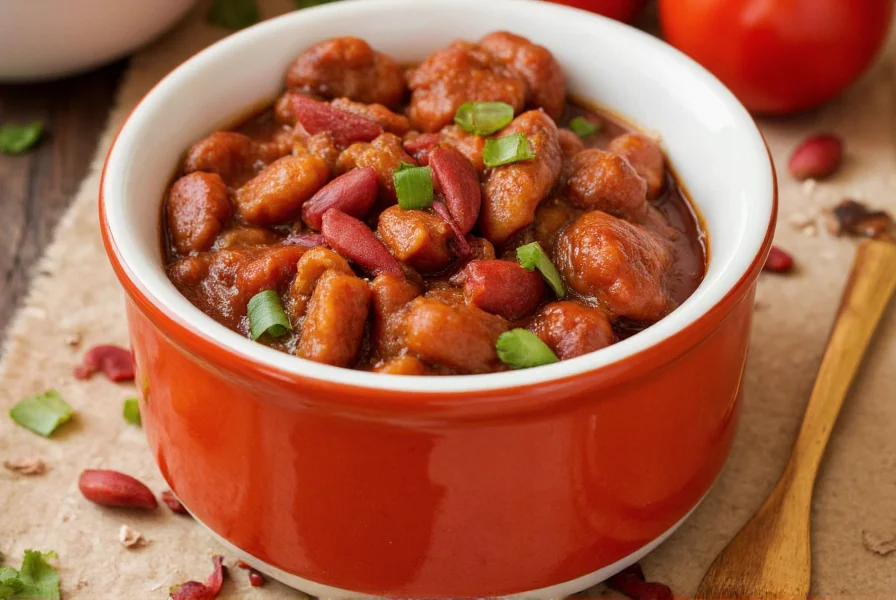Creating exceptional home cooked chili isn't just about following a recipe—it's understanding the science of flavor development and texture. The magic happens when you properly brown your meat, toast your spices, and allow sufficient simmering time for flavors to meld. Unlike canned or restaurant versions, homemade chili gives you complete control over ingredients, heat level, and consistency.
The Essential Components of Authentic Homemade Chili
Every memorable batch of slow cooked chili begins with three critical elements: quality protein, thoughtful spice blending, and proper cooking technique. Traditional chili con carne ("chili with meat") traditionally uses coarsely ground or cubed beef chuck, which provides the ideal fat content for flavor without excessive greasiness. For vegetarian home cooked chili, a combination of mushrooms, lentils, and textured vegetable protein creates satisfying texture and umami depth.

Ingredient Breakdown: Quality Matters
The difference between good and great homemade chili often comes down to ingredient selection:
| Ingredient | Quality Recommendation | Why It Matters |
|---|---|---|
| Meat | 80/20 ground chuck or 1" beef cubes | Proper fat content renders during cooking for rich flavor without greasiness |
| Chili Powder | Fresh, high-quality blend (check expiration) | Stale spices lose potency and can taste bitter |
| Tomatoes | Whole peeled San Marzano in puree | Sweeter, less acidic than regular canned tomatoes |
| Beans | Dried, soaked overnight (kidney or pinto) | Hold shape better and have creamier texture than canned |
Step-by-Step Traditional Chili Preparation
Follow this method for authentic homemade chili that develops complex flavors:
- Prepare ingredients: Dice onions, mince garlic, measure spices. Soak dried beans overnight if using.
- Brown meat properly: Heat oil in heavy pot, brown meat in batches without crowding. Remove and set aside.
- Build flavor foundation: In same pot, cook onions until translucent, add garlic, then toast dry spices for 1-2 minutes until fragrant.
- Layer liquids: Add tomatoes, broth, and rehydrated beans. Return meat to pot.
- Slow simmer: Cover partially and cook on low heat for 2-4 hours, stirring occasionally.
- Final adjustments: Skim excess fat, adjust seasoning, and thicken if necessary by simmering uncovered.
Avoiding Common Homemade Chili Mistakes
Even experienced cooks make these errors when preparing traditional chili con carne:
- Rushing the browning process: Crowding the pan steams meat instead of searing it, preventing proper Maillard reaction.
- Adding spices too early: Toast spices in the oil after aromatics for maximum flavor release.
- Overcooking beans: Add beans during the last 60-90 minutes to prevent disintegration.
- Skipping the resting period: Let chili sit off heat for 15-30 minutes before serving for flavors to fully integrate.
- Incorrect thickening method: Avoid cornstarch; instead, mash some beans or simmer uncovered to reduce.
Variations for Different Tastes and Diets
Adapt your slow cooked chili to suit various preferences while maintaining authentic flavor:
- Texas-style: Omit beans and tomatoes for pure meat-and-chili focus
- Colorado red: Use only dried red chilies (New Mexico, Ancho) for deep, complex heat
- White chili: Substitute chicken or turkey with white beans and green chilies
- Vegan option: Use mushrooms, walnuts, and textured vegetable protein with smoked paprika
- Low-sodium version: Use no-salt-added tomatoes and create your own spice blend

Serving and Storage Recommendations
Proper presentation and storage maximize your home cooked chili experience:
- Serving temperature: Serve hot but not boiling—ideal temperature is 165-175°F (74-80°C)
- Traditional toppings: Offer sour cream, shredded cheddar, diced onions, and oyster crackers separately
- Accompaniments: Cornbread, saltine crackers, or rice complement traditional chili con carne
- Refrigeration: Store in airtight container for up to 5 days
- Freezing: Portion into freezer bags (lay flat) for up to 6 months; thaw overnight in refrigerator
Frequently Asked Questions
How long should I cook homemade chili for optimal flavor?
For best results, simmer your home cooked chili for 2-4 hours on low heat. The first 90 minutes develop basic flavors, while additional cooking time (up to 4 hours) allows complex flavor compounds to form. Many chili enthusiasts find that chili tastes even better the second day after flavors have fully melded in the refrigerator.
What's the secret to making chili less watery without compromising texture?
Rather than using thickeners like cornstarch, try these authentic methods: simmer uncovered for the last 30-60 minutes to reduce liquid naturally, mash 1/4 of the beans before adding them, or create a small roux with reserved meat drippings and flour. For traditional chili con carne, proper meat browning creates fond that naturally thickens the base.
Can I make authentic-tasting chili in less time without losing flavor?
Yes, with strategic shortcuts: use pre-toasted spices (toast them in a dry pan for 1 minute before adding), incorporate a small amount of strong coffee or dark beer for depth, and finish with a splash of vinegar or lime juice to brighten flavors. While slow cooking develops the most complex taste, these techniques can produce satisfying home cooked chili in about 90 minutes.
What's the difference between chili powder and chili seasoning?
Chili powder is primarily ground dried chilies (often cayenne) with minimal additives, while chili seasoning contains additional ingredients like garlic powder, onion powder, cumin, and salt. For authentic homemade chili, use pure chili powder and add individual spices to control flavor balance. Pre-mixed seasoning works in a pinch but often contains fillers and excessive salt.
How can I adjust the heat level in my homemade chili?
Control heat through ingredient selection rather than just adding more cayenne. For mild chili, use New Mexico chilies or paprika. Medium heat comes from Ancho or Guajillo chilies. For hotter chili, incorporate Chipotle (smoky heat) or Arbol (sharp heat). Remember that heat intensifies over cooking time, so add spicy elements gradually. If chili becomes too hot, add acidity (lime juice) or sweetness (a pinch of sugar) to balance.











 浙公网安备
33010002000092号
浙公网安备
33010002000092号 浙B2-20120091-4
浙B2-20120091-4